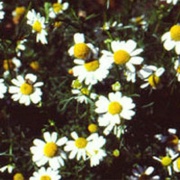Chamomile dye
Description
A yellow dye obtained from perennial herbs such as chamomile (Anthemis nobilis), corn chamomile (Anthemis arvensis), or dyer's chamomile (Anthemis tinctoria) that are native to Europe. Chamomile has been grown in gardens since medieval times as ground cover between stones in a walking path. The dried flowers, obtained from the plants or teabags, are used to produce a buff color on Wool with an aluminum mordant and a golden color on wool with a chrome mordant.
Synonyms and Related Terms
Anthemis nobilis (chamomile), Anthemis arvensis (corn chamomile); Anthemis tinctoria (dyer's chamomile, yellow chamomile, golden chamomile, or golden marguerite); CI 75580; Natural Yellow 1; camomila (Esp., Port.); manzanilla (Esp.); camomilla (It.); apigenin; camomile
| Composition | C15H10O5 |
|---|---|
| CAS | 520-36-5 |
Authority
- R.J. Adrosko, Natural Dyes in the United States, Smithsonian Institution Press, Washington, DC, 1968
- S. M. Robertson, Dyes From Plants, Van Nostrand Reinhold Company, 1973
- Helmut Schweppe, Schweppe color collection index and information book
- Palmy Weigle, Ancient Dyes for Modern Weavers, Watson-Guptill Publications, New York, 1974
- Random House, Webster's Encyclopedic Unabridged Dictionary of the English Language, Grammercy Book, New York, 1997
- The Merck Index, Martha Windholz (ed.), Merck Research Labs, Rahway NJ, 10th edition, 1983 Comment: entry 2082
- The American Heritage Dictionary or Encarta, via Microsoft Bookshelf 98, Microsoft Corp., 1998
- Colour Index International online at www.colour-index.org
- Sigma Dyes, Stains and Natural Pigments, Infrared Library, Nicolet, 1991-1995
